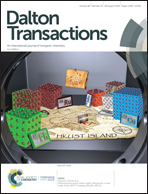Molybdenum carbide catalyst for the reduction of CO2 to CO: surface science aspects by NAPPES and catalysis studies†
Abstract
Carbon dioxide is a greenhouse gas, and needs to be converted into one of the useful feedstocks, such as carbon monoxide and methanol. We demonstrate the reduction of CO2 with H2 as a reducing agent, via a reverse water gas shift (RWGS) reaction, by using a potential and low cost Mo2C catalyst. Mo2C was evaluated for CO2 hydrogenation at ambient pressure as a function of temperature, and CO2 : H2 ratio at a gas hourly space velocity (GHSV) of 20 000 h−1. It is demonstrated that the Mo2C catalyst with 1 : 3 ratio of CO2 : H2 is highly active (58% CO2 conversion) and selective (62%) towards CO at 723 K at ambient pressure. Both properties (basicity and redox properties) and high catalytic activity observed with Mo2C around 700 K correlate well and indicate a strong synergy among them towards CO2 activation. X-ray diffraction and Raman analysis show that the Mo2C catalyst remains in the β-Mo2C form before and after the reaction. The mechanistic aspects of the RWGS reaction were determined by near-ambient pressure X-ray photoelectron spectroscopy (NAPXPS) with in situ generated Mo2C from carburization of Mo-metal foil. NAPXPS measurements were carried out at near ambient pressure (0.1 mbar) and various temperatures. Throughout the reaction, no significant changes in the Mo2+ oxidation state (of Mo2C) were observed indicating that the catalyst is highly stable; C and O 1s spectral results indicate the oxycarbide species as an active intermediate for RWGS. A good correlation is observed between catalytic activity from atmospheric pressure reactors and the electronic structure details derived from NAPXPS results, which establishes the structure–activity correlation.



 Please wait while we load your content...
Please wait while we load your content...